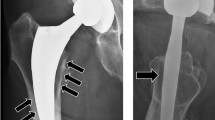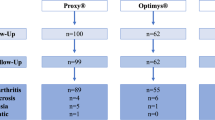Abstract
Introduction
The purpose of this study consisted in examining the effects of fit and fill ratio of the Metha® prosthesis (BBraun, Aesculap, Tuttlingen, Germany) on radiological and clinical outcomes at a follow-up of 1 year.
Methods
40 patients were included. Fit and fill ratio measurements, radiological and clinical examinations were performed preoperatively and postoperatively. Correlations were established between fit and fill ratio, and potential factors like sex, age, body mass index, Harris Hip Score and changes of radiological signs.
Results
The whole cohort (100 %) had a tight fit and fill ratio (>0.8) at the proximal level and at each follow-up. “Champagne-flute” configuration provoked high distal tight-fit and fill ratio. Poor distal fit and fill ratio compared to the proximal and the mid-stem level was measurable at each follow-up (p < 0.05). Correlations between fit and fill ratio and preoperative femur configurations were detectable.
Conclusions
Implanting the Metha® prosthesis induces tight fit and fill ratio at the proximal and coated sections. Preoperative femur configuration should be considered to achieve best fit and fill situation and therefore excellent primary stability. In most cases “normal” and “stove-pipe” configurations provide good proximal fit and fill. Since “champagne-flute” configuration induces undesirable tight distal fit and fill ratio the size of the Metha® stem should be adequately increased to achieve a more proximal load transmission.



Similar content being viewed by others
References
Laine HJ, Pajamäki KJ, Moilanen T, Lehto MU (2001) The femoral canal fill of two different cementless stem designs. The accuracy of radiographs compared to computed tomographic scanning. Int Orthop 25(4):209–213
Wolff J (1899) Die Lehre von der functionellen Knochengestalt. Virchows Arch 155(2):256–315
van der Wal BC, de Kramer BJ, Grimm B, Vencken W, Heyligers IC, Tonino AJ (2008) Femoral fit in ABG-II hip stems, influence on clinical outcome and bone remodeling: a radiographic study. Arch Orthop Trauma Surg 128(10):1065–72 (Epub 2007 Dec 6)
Poss R, Walker P, Spector M, Reilly DT, Robertson DD, Sledge CB (1988) Strategies for improving fixation of femoral components in total hip arthroplasty. Clin Orthop Relat Res (235):181–194
Issa K, Pivec R, Wuestemann T, Tatevossian T, Nevelos J, Mont MA (2014) Radiographic fit and fill analysis of a new second-generation proximally coated cementless stem compared to its predicate design. J Arthroplasty 29(1):192–198. doi:10.1016/j.arth.2013.04.029 (Epub 2013 May 21)
Kim YH, Kim VE (1993) Uncemented porous-coated anatomic total hip replacement. Results at 6 years in a consecutive series. J Bone Joint Surg Br 75(1):6–13
Aubaniac JM, Argenson JN (1995) Why use a custom-made hip prosthesis? A 10-tear experience. Surg Technol Int IV:457–463
Dorr LD, Lewonowski K, Lucero M, Harris M, Wan Z (1997) Failure mechanisms of anatomic porous replacement I cementless total hip replacement. Clin Orthop Relat Res (334):157–167
Huiskes R (1999) The various stress patterns of press-fit, ingrown, and cemented femoral stems. Clin Orthop Relat Res (261):27–38
Le D, Smith K, Tanzer D, Tanzer M (2011) Modular femoral sleeve and stem implant provides long-term total hip survivorship. Clin Orthop Relat Res 469(2):508–513. doi:10.1007/s11999-010-524-0
Hirata Y, Inaba Y, Kobayashi N, Ike H, Fujimaki H, Saito T (2013) Comparison of mechanical stress and change in bone mineral density between two types of femoral implant using finite element analysis. J Arthroplasty 28(10):1731–1735. doi:10.1016/j.arth.2013.04.034 (Epub 2013 May 15)
Clarke HJ, Jinnah RH, Cox QG, Curtis MJ (1992) Computerized templating in uncemented total hip arthroplasty to assess component fit and fill. J Arthroplasty 7(3):235–239
Bert JM(1996) Custom total hip arthroplasty. J Arthroplasty 11(8):905–915
Dujardin FH, Mollard R, Toupin JM, Coblentz A, Thomine JM (1996) Micromotion, fit, and fill of custom made femoral stems designed with an automated process. Clin Orthop Relat Res (325):276–289
Engh CA, Massin P (1989) Cementless total hip arthroplasty using the anatomic medullary locking stem. Results using a survivorship analysis. Clin Orthop Relat Res (249):141–158
Jahnke A, Engl S, Altmeyer C, Jakubowitz E, Seeger JB, Rickert M, Ishaque BA (2014) Changes of periprosthetic bone density after a cementless short hip stem: a clinical and radiological analysis. Int Orthop 38(10):2045–2050. doi:10.1007/s00264-014-2370-6 (Epub 2014 Jun 11)
Frndak PA, Mallory TH, Lombardi AV Jr (1993) Translateral surgical approach to the hip. The abductor muscle “split”. Clin Orthop Relat Res (295):135–141
Hardinge K (1982) The direct lateral approach to the hip. J Bone Joint Surg Br 64(1):17–19
Harris WH (1969) Traumatic arthritis of the hip after dislocation and acetabular fractures: treatment by mold arthroplasty. An end-result study using a new method of result evaluation. J Bone Joint Surg Am 51(4):737–755
Panisello JJ, Herrero L, Herrera A, Canales V, Martinez A, Cuenca J (2006) Bone remodelling after total hip arthroplasty using an uncemented anatomic femoral stem: a three-year prospective study using bone densitometry. J Orthop Surg (Hong Kong) 14(1):32–37
Gruen TA, McNeice GM, Amstutz HC (1979) “Modes of failure” of cemented stem-type femoral components: a radiographic analysis of loosening. Clin Orthop Relat Res (141):17–27
Noble PC, Alexander JW, Lindahl LJ, Yew DT, Granberry WM, Tullos HS (1988) The anatomic basis of femoral component design. Clin Orthop Relat Res (235):148–165
Engh CA, Massin P, Suthers KE (1990) Roentgenographic assessment of the biologic fixation of porous-surfaced femoral components. Clin Orthop Relat Res 257:107–128
Mulliken BD, Nayak N, Bourne RB, Rorabeck CH, Bullas R (1996) Early radiographic results comparing cemented and cementless total hip arthroplasty. J Arthroplasty 11(1):24–33
Ishaque BA, Stürz H, Basad E (2011) Fatigue fracture of a short stem hip replacement: a failure analysis with electron microscopy and review of the literature. J Arthroplasty 26(4):665.e17–665.e20. doi:10.1016/j.arth.2010.05.021 (Epub 2011 Apr 16)
Jakubowitz E, Seeger JB, Lee C, Heisel C, Kretzer JP, Thomsen MN (2009) Do short-stemmed-prostheses induce periprosthetic fractures earlier than standard hip stems? A biomechanical ex vivo study of two different stem designs. Arch Orthop Trauma Surg 129(6):849–855
Effenberger H, Imhof M, Witzel U, Rehart S (2005) Zementfreie Hüftschäfte: Aktueller Stand. Orthopade 34:477–502
Author information
Authors and Affiliations
Corresponding authors
Ethics declarations
Conflicts of interest
The authors declare that they have no conflict of interest.
Rights and permissions
About this article
Cite this article
Jahnke, A., Engl, S., Seeger, J.B. et al. Influences of fit and fill following hip arthroplasty using a cementless short-stem prosthesis. Arch Orthop Trauma Surg 135, 1609–1614 (2015). https://doi.org/10.1007/s00402-015-2302-y
Received:
Published:
Issue Date:
DOI: https://doi.org/10.1007/s00402-015-2302-y




